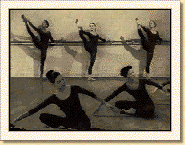|
Not many people "get" modern dance. Why? It's really hard to describe. "It's like ballet but it's totally
different" is the answer the curious usually get. I will attempt to explain it here.
Modern is usually described as "the cousin of ballet," because it is based on ballet technique. Why? Because
many of the founders of modern were ballerinas gone awry. They thought, "dude, this is so BORING! you can only stick
within the lines of ballet steps." So, they went off into their own little world and formed modern.
Modern is really cool, because unlike ballet, it isn't limited to the steps that are already invented - pirouettes,
plies, etc. Modern is based on "thinking outside the box." Basically, the rules are: if it looks cool, go ahead
and do it! Modern can be based on eastern relgions, tell a story, or express emotion. My teacher is choreographing a dance
about September 11.
There's a lot more to some forms of modern dance than you'd think. Most modern dancers simply want a different way
of expressing themselves. They think that the movements of ballet are too small to do that. They think that dancing must
not be about technique, but about movement itself.
@-->--
"Some kind of tag had to be given to this new dance that was not ballet. "Esthetic" and "interpretive,"
barely suitable for the free dance forms generated by Duncan and St. Denis, could hardly be used to describe Martha's "Revolt"
or "Heretic." So the term "modern dance" came into useage. It was intended as a stopgap description.
The "Moderns" never liked it, but they were stuck with it." ~"Frontiers of Dance, The Life of Martha Graham,"
by Walter Terry
@-->---
Modern has several "theories," formed by the "founders of modern." I've only learned a few, so
give me a break if I screw up...i'm new to all this...:*)
THEORY OF CONTRACTION AND RELEASE
Martha Grahm (i believe that's how u spell it) was one of these rebel ballerinas. She formed a theory that all dance
is formed by muscles contracting and releasing. For example, it I lift my leg, my thigh muscles contract and those under-the-leg
muscles (getting real techinical here) release. There are two excercises to practice this: contractions, and releases. (I
just learned these today...I'll try my best..)
*A CONTRACTION is when you pull you stomach in, as if you'd been punched. You keep your shoulders straight and don't
rock your pelvis (stay balanced on your sitbones, as Sam (Miss Samantha...modern teacher) says). Your arms are out on your
sides, and they move forward and tense as you contract. You should be able to see your arm muscles (and yes, you SHOULD
have some). Your hands are cupped and make little dishes, and your fingers stick together. Sorta like the royal wave, you
know?
*A RELEASE is when you straighten your back back to its normal position. Your hands remain cupped and your arms are raised
at your sides, elbows bent.
*WHY IS THIS IMPORTANT? A lot of modern takes place in your upper body. Dance is made dramatic by arching your back,
or leaning back, or curling it or whatever. If you're a dancer, your back better be strong. This also helps your abodomen
(i didnt spell that right)a lot, which is helpful in many ways in supporting your body at all times.
@--->---
"Martha did not use relaxation. She never relaxed. Contraction was like a clecnhed fist; releasing it would be
to return to a normal state, not floppy in complete relaxation. She could do the same with fingers, a shoulder, a foot, any
place with a muscle. If she contracted her entire torso as an expectant mother might do to aid the delivery of a baby, the
contraction, if sufficienty forceful, could carry her body from an upright position right down to the floor. In Martha's
mind such actions could be the very stuff of dramatic dance, revealing the inside on the outside." ~"Frontiers
of Dance, The Life of Matha Graham," by Walter Terry
@--->---
THEORY OF FALL AND RECOVERY
I forget who made this one up...sorry. Anyway... remember when you're a little kid and you used to swing all the time?
Do you remember that feeling JUST as you reached the top, the highest you could go, before you went back down again? Well,
that's the type of feeling you're going for here. You run up, you reach the height of your movement, and you "recover"
and go back down, and repeat that over and over and over again. I'm not explaining this too well, but I hope you get what
I'm driving at.
*SWINGS is what Sam calls these. You run forward on releve, then stop, then get that unbalanced feeling when you're JUST
going to fall, then step back and turn and run back to wherever you're supposed to...across the room, say, "recover"
and do it again, turn, run back, etc, etc. Pretty simple.
*WHY THIS IS IMPORTANT~ This isn't so much important as it is a basic step you will find in modern choreography. Depending
on what type of dance you're doing, these can be modified to add arm movements and can look really cool in a dance. Add contractions
before you "fall" and they look REALLY funky! ;)
***above picture from the Circle Dance Company - clarion.korrnet.org/circle/***
MoreAboutMartha
MoreHistoryofModern
|
|
|
|
 |
|
Modern also has a couple *BASIC STEPS* you can't do without. Here's a few...er....there will be a few...
*PRANCES~Have you ever seen a horse walk? Watch its legs. It doesn't seem to be moving forward; its legs seem to stay
in once place, because it's got four, but only two go up at a time. That's what you want to try to achieve with prances -
you want to look like you aren't moving.
First, you've got to practice the basic movement. Lift up one leg, bent at the knee. Practice switching leg to leg,
going up on releve (on your toes) every time. Don't think about lifting your leg UP, think OUT. Now practice this going
forward, in a mirror. Make sure you're in releve each time. This could take a while. Start out slow but speed up with practice.
I'm trying to explain this and have it make sense, but I don't think it's working. Oh well. I hope you get the jist
of it.
@--->---
*HINGES~I dunno whether this is a "basic step" or not, but it's a kind of technique, so we'll see. The key
rule in doing a hinge is to KEEP YOUR TORSO TOGETHER. DO NOT arch your back! If you do, you're gonna fall, and it's gonna
hurt. Use those abs!
Now, what you need to do is lean back. Yes, that's what a hinge is - lean back. Keep your heels on the floor and keep
your back straight. Keep it all together and in line with your thighs. Scared? Yeah. Get a friend/dance teacher to hold
your hands while you do this. Go as far as you can without popping up your heels, then - just when you're about to fall -
twist whichever way feels right and put that sholder on the floor and push back, go skidding on the floor. Ouch? YES!!
But it's fun, somehow. DO NOT put your hand/arm down, unless you KNOW you're going to fall. If you do, you're not going to
get it.
Don't get freaked if you can't do this - Sam (modern teacher) can't. She's very short, and says she has a short
Achilles tendon (?SP?). So we must all PRACTICE, right? How many times have we heard that? ugh. but that's life.
@--->---
*TIPS*
~Keep your TORSO together!
~Keep your BODY BALANCED and FORWARD, on the balls of your feet. If you let your weight fall back you won't be able to
move quick enough!
~TIE THE STEPS together. Don't dance choppy! It's a story, keep it moving!
~COUNT the music!
~LOOK where you're going! They tell you to spot for a reason, you know. If you're not in the right place, well, time
to start makin' things up!
~PRACTICE makes perfect! If you're bored and haven't much to do, start stretching. Do barre exercises on the back of
your chair or a kitchen counter. Practice your steps constantly! If you can't practice, run over the steps in your mind.
I find that helps a lot, and keeps me clear on what I'm doing.
~WATCH YOUR ARMS. Your teacher put them where they are for a reason. Even if YOU think it looks weird, it could make
all the difference to an audience later on!
~Your BODY PLACEMENT often sets you up for something later on in the dance, and is key to what you are doing. Be careful,
for a little shift in your weight can mean the difference between "graceful leg extention" and "dog-peeing-on-a-fire-hydrant"!!
~STRETCH before you dance. Don't want to hurt any of those lovely legs, now do we??
~HAVE FUN! Dance 'cuz you love it, chicas! Remember: Dancas rule!
*Below pic of a Graham modern class*

|
|
|
|



